Exploring the Red Line Metro Stations in Dubai
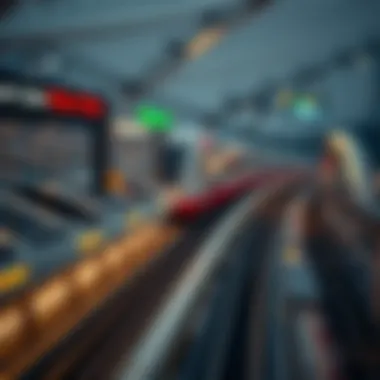

Intro
Dubai's urban landscape is like a well-crafted mosaic, and the Red Line metro system is a key tile that holds it all together. This metro line does not just connect people from point A to point B; it’s a lifeline for commuters and tourists, intertwining various neighborhoods and major commercial hubs. In this article, we will peel back the layers of the Red Line, showcasing the significance of each station and their role in fostering connectivity within the city.
As we go through the various stops, we'll not only delve into the essential facilities offered at each station but also explore the surrounding areas, focusing on the local hotspots and residential developments that thrive because of easy access to public transport.
Additionally, we will examine how the presence of the metro impacts Dubai's real estate market, offering insights relevant to investors and homeowners seeking to navigate this dynamic environment. With attractions sprouting up alongside the metro line, understanding the market landscape becomes increasingly vital for anyone interested in making savvy investment choices.
Let's kick off this journey by diving into the current market trends that are shaping Dubai's real estate scene.
Preamble to the Red Line Metro System
The Red Line Metro System in Dubai represents an essential component of the city's public transportation framework. It is curiously both a mirror of Dubai's rapid development and a lifeline for both residents and tourists. The significance of the Red Line can hardly be overstated; it not only connects various districts but also symbolizes the city’s ambition to create a modern, efficient infrastructure that accommodates the growing urban population.
Historical Background
The genesis of the Red Line originated in the mid-2000s, when Dubai realized the pressing need for a structured mass transit option amid a construction boom. The initial vision set forth by the Dubai government materialized in 2009 when the first segment of the metro was inaugurated. With the Red Line stretching approximately 52 kilometers, it now serves as a shortcut through some of the city's most bustling landmarks, such as the Burj Khalifa and the Dubai Marina. Coordinated efforts by local authorities and international engineers not only overcame the engineering challenges but also exemplified Dubai’s capacity to innovate in the face of adversity. The result was a project lauded globally, transforming the way people navigate this rapidly-growing metropolitan success story.
Importance of the Red Line
The Red Line is more than just a mode of transport; it’s an urban game changer. For one, it dramatically reduces travel time across pivotal areas, which is a significant factor given Dubai's notorious traffic congestion. Commuters who once spent hours on the road can now rely on a swift metro ride. Moreover, the Red Line enhances connectivity between vital neighborhoods, commercial hubs, and leisure destinations like shopping malls and parks.
Furthermore, the metro also plays a notable role in shaping real estate trends. Proximity to a metro station often influences property values, making areas within a short walk much more desirable. Investors are increasingly eyeing properties close to stations such as the Dubai Mall and Mall of the Emirates, knowing that accessibility can significantly affect their investment's appeal and liquidity.
In summary, the Red Line Metro System is an integral artery that facilitates not just the flow of people but also the pulse of the city's commercial and social life. As we delve deeper into each station, their connections, and the neighborhoods they serve, one thing becomes clear: the Red Line is a crucial piece of Dubai's urban puzzle.
Complete List of Red Line Metro Stations
Understanding the Complete List of Red Line Metro Stations is crucial for anyone navigating Dubai's intricate transit network. Each station serves as a hub of activity, linking commuters to various districts and amenities across the city. Knowing these stations not only aids in travel planning but also provides insight into real estate opportunities and urban development trends in their vicinity.
The Red Line of Dubai Metro is designed to cover significant areas, enhancing mobility for both residents and tourists. These stations are strategically located near major landmarks, shopping centers, and residential neighborhoods. As a result, they play a vital role in the overall effectiveness of the public transport system, making daily commutes smoother and more efficient.
Early Stations
The early stations of the Red Line laid the groundwork for what would become a thriving metro system. Key stations in this category include Rashidiya Station, Airport Terminal 1 Station, and Airport Terminal 3 Station.
- Rashidiya Station: This station is a gateway for those traveling from Dubai’s eastern suburbs. It connects many commuters to their workplaces and schools, serving a diverse population.
- Airport Terminal 1 Station & Terminal 3 Station: These stations facilitate easy access to international travel, accommodating millions of passengers annually. The proximity to Dubai International Airport enhances the importance of these stations, ultimately boosting business and tourism.
Central Stations
As we move toward the heart of the city, the Central Stations emerge as true transit marvels. Stations here, such as Burj Khalifa/Dubai Mall Station, Emirates Towers Station, and World Trade Centre Station, are synonymous with familiarity and convenience.
- Burj Khalifa/Dubai Mall Station: This station attracts tourists and residents alike, being close to the towering Burj Khalifa and the expansive Dubai Mall. Here, the urban experience intertwines with leisure, shopping, and cultural engagements.
- Emirates Towers Station: This station serves as a dynamic connection point for business professionals, linking commercial hubs with residential areas. Its strategic position speaks to the commercial growth in Dubai.
- World Trade Centre Station: Central to numerous expos, conferences, and events, this station supports the city’s economy while showcasing Dubai's prowess as a global business center.
Western Stations
In the western section of the Red Line, stations like Dubai Marina Station, Mall of the Emirates Station, and Al Rigga Station further extend the metro's reach and influence.
- Dubai Marina Station: Known for its luxurious living and picturesque waterfront, this station connects residents to both leisure and employment opportunities, fostering an attractive lifestyle.
- Mall of the Emirates Station: Serving a landmark shopping destination, this station appeals to both leisurely shoppers and serious buyers, making it a bustling hub throughout the week.
- Al Rigga Station: Located in the culturally rich area of Al Rigga, this station represents a blend of heritage and modernity, attracting those interested in exploring traditional and contemporary Dubai.
In summation, the Complete List of Red Line Metro Stations not only reflects the city's growth over time but also highlights its ambitions to create a world-class transportation system. Each station has its unique contributions to urban mobility and regional development, which is essential for stakeholders involved in real estate and municipal planning.
The Red Line metro stations collectively demonstrate how effective transit systems can drive urban development, shaping communities and enhancing quality of life.
For further information, consider visiting Wikipedia or Dubai Metro Official Site.
Utilizing the metro becomes easier when you recognize which stations matter most, be it for commuting or investment decisions.
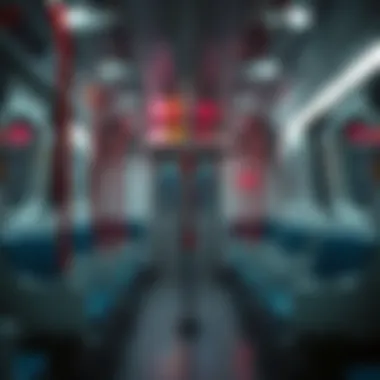
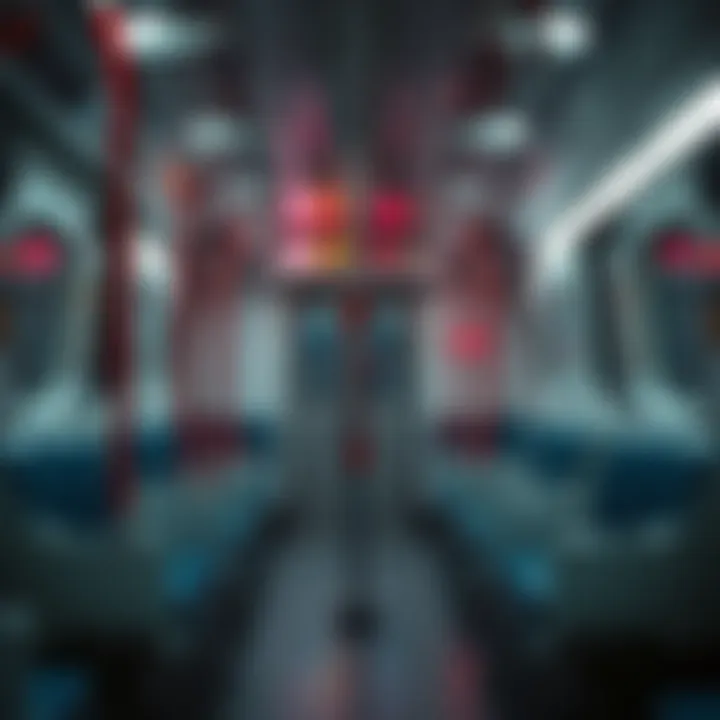
Detailed Overview of Each Station
The Red Line of Dubai's Metro system stands as a testament to the city’s commitment to modern public transportation. Each station along this route is like a spoke in the wheel of urban mobility, offering unique insights not only into the transport dynamics of the area but also the lifestyle and amenities found at each stop. Understanding the particulars of each station is vital for anyone looking to navigate the city effectively, whether for daily commutes or leisure activities. This section will delve into the intricacies that characterize each key station along the Red Line, spotlighting their features, accessibility, and the attractions in their vicinity.
Burj Khalifa/Dubai Mall Station
Key Features
The Burj Khalifa/Dubai Mall Station is a crown jewel in the Red Line system. Its architecture complements the iconic skyscraper and adjacent shopping center, creating an aesthetic marvel. An important aspect here is the station's capacity; it efficiently handles a substantial footfall coming from both tourists and locals. The unique feature of this station is its direct connection to the world’s tallest building, Burj Khalifa, offering seamless access for those wishing to explore its observation decks. This connection plays a crucial part in enhancing the overall user experience, facilitating easy transitions from metro to mall.
Accessibility
Accessibility at the Burj Khalifa/Dubai Mall Station is designed to cater to all. Elevators and escalators allow easy movement for those with disabilities or heavy luggage. A distinctive point is its underground connectivity to the mall itself, making it a sheltered route against the often intense Dubai heat. This thoughtful planning ensures that travelers can navigate with ease, making the station a practical choice for anyone traveling to central Dubai.
Nearby Attractions
The surrounding area of this station is packed with attractions. The immediate access to the Dubai Mall, which boasts over 1,200 retail outlets, giant aquarium, and a myriad of dining options, makes it a popular stop for shoppers and tourists alike. Just a short stroll away, visitors can enjoy the Dubai Fountain and the Burj Park, where stunning views of Burj Khalifa can be savored. The array of options significantly adds to the station's appeal, positioning it as a robust hub of activity.
Dubai Marina Station
Key Features
Dubai Marina Station shines as a bridge connecting the charm of waterfront living to the urban core. One standout aspect is its modern design that mirrors the aesthetic of the marina architecture. The station is built to handle high passenger volumes, particularly during peak hours, which underscores its significance within the transport network. A notable feature is its proximity to upscale residential complexes, hotels, and leisure areas, serving as a critical node for residents and tourists alike.
Accessibility
Accessibility is a strong point with this station boasting multiple access points and clear signage that aids newcomers and travelers alike. The platform-level access to the marina promenade encourages healthy foot traffic and offers a scenic route for those wishing to explore the waterway. It’s easy to see why this station remains a top choice, considering people can hop off the train and dive straight into a variety of leisure activities.
Nearby Attractions
Nearby, visitors find a slice of Dubai's vibrant life through the Dubai Marina Walk. This picturesque pathway is peppered with cafes, restaurants, and stores, catering to any taste. For those looking to enjoy marine activities, water taxis and boat cruises are readily available, enhancing the station's allure as a multifaceted destination for both relaxation and adventure.
Mall of the Emirates Station
Key Features
Mall of the Emirates Station is an exemplary representation of how the metro stations integrate with shopping as a lifestyle. The station’s features include spacious platforms and high ceilings that create an inviting atmosphere. A unique aspect here is its direct access to the Mall of the Emirates, known for its indoor ski slope and extensive range of stores. These design choices emphasize its role as a social hub rather than merely a transit point.
Accessibility
Given its status, accessibility is paramount. The station is equipped with ramps, elevators, and designated pathways that help individuals with mobility challenges. A key characteristic is its integration with the mall, allowing passengers to escape the elements without hassle. This convenience adds value for families and travelers carrying shopping bags or winter sports gear from the ski slope.
Nearby Attractions
Adjacent to the station, the Mall of the Emirates is not just a shopping destination but a full-fledged entertainment complex. From cinemas to diverse dining experiences, it attracts people of all ages. The unique blend of retail and leisure options ensures that this station feels like a destination in its own right, rather than just a pit stop.
Al Rigga Station
Key Features
Al Rigga Station is a gateway to the vibrant and culturally rich area of Deira. Its distinct architectural style represents the fusion between modern transit facilities and the traditional aspects of Dubai’s heritage. A key feature includes its open-air design that allows fresh air to circulate, which is a bit of a rarity in some configurations of urban stations. This station serves as a vital link for those commuting to the local business districts and residential neighborhoods.
Accessibility
Accessibility here is user-friendly, with clear markers directing passengers. Eye-catching signages promote local businesses, drawing in not just commuters but also walk-in customers from the streets. Notable is the proximity to several taxi ranks that enhance the overall connectivity, making it an enticing option for those who prefer multiple modes of transport.
Nearby Attractions
This station offers easy access to a plethora of local eateries and shops that reflect Dubai's rich flavor. The bustling surroundings provide an authentic feel of the traditional market experience, making it an attraction in its own rite. The hospitality displayed by local vendors creates a welcoming atmosphere that’s often sought after by visitors eager to engage with Dubai's culture.
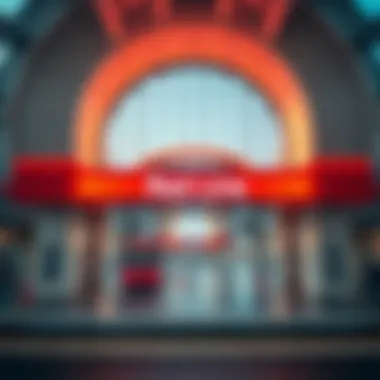
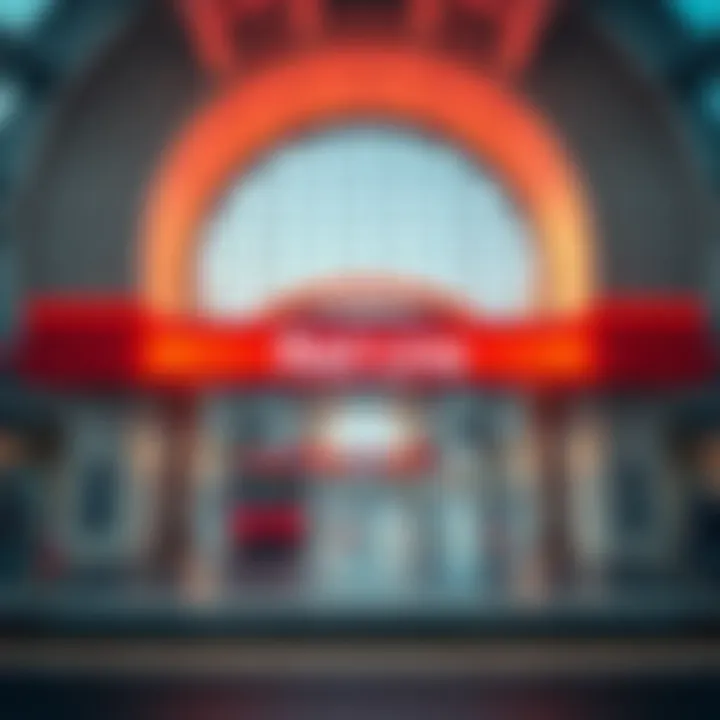
Dubai Airport Terminal and Stations
Key Features
Located strategically, the Dubai Airport Stations serve as the pivotal link between air travel and city transportation. The commuter-focused layout is designed to facilitate seamless transit for both travelers and workers. One standout aspect is the dedicated lanes for baggage trolleys, ensuring enhanced mobility for air travelers. Such features streamline the transition between the metro and the airport, simplifying the travel process significantly.
Accessibility
Accessibility at these stations has been taken into consideration, with ample signage in multiple languages. Moreover, the design incorporates wide pathways for ease of movement, especially for those dragging luggage. The layout is practical, focusing on the everyday needs of both locals and tourists. A distinctive feature is the direct escalator access to terminals, greatly reducing accidental misdirections.
Nearby Attractions
Beyond just travel, the airport stations are surrounded by facilities that cater to various needs of travelers. Nearby hotels and short-term lodging facilitate quick stays for those in transit. Additionally, the knowledge hubs and information points at the stations equip tourists with insights into local attractions, enhancing the overall experience of their visit to Dubai.
Overall, each station along the Red Line not only serves as a stop on the metro route but also enriches the urban landscape by providing context to their respective localities. Understanding these stations gives valuable insight to investors, homeowners, and anyone considering making Dubai their home or a short-term visit.
Comparative Analysis of Red Line Stations
The analysis of the Red Line stations is pivotal in understanding their individual and collective roles within Dubai's dynamic urban landscape. This section delves into key metrics like utilization rates and surrounding real estate trends, offering insights into how these elements interplay to shape commuter experiences and property values. By assessing how each station caters to user demand and impacts its vicinity, investors and urban planners can make informed decisions regarding future developments or adjustments in strategy.
Utilization Rates
When evaluating the Red Line stations, utilization rates serve as a vital indicator of their popularity and effectiveness in meeting the transportation needs of both residents and tourists. The instances of daily ridership can vary significantly across stations, influencing operational decisions and even future expansions.
- Burj Khalifa/Dubai Mall Station leads the pack, consistently recording high foot traffic due to its proximity to major attractions, making it the go-to stop for tourists.
- Dubai Marina Station, another high-traffic area, also sees a significant amount of commuters, particularly residents heading to work or leisure activities.
- Conversely, stations like Al Rigga may experience fluctuations in usage, often reflecting broader local economic activities and events in surrounding neighborhoods.
Understanding these patterns not only helps transport authorities optimize services but also helps investors to gauge where to stake their real estate claims. A station with a rapid increase in utilization might indicate a burgeoning area ripe for residential or commercial development.
Surrounding Real Estate Trends
In conjunction with utilization rates, examining surrounding real estate trends is essential in grasping how the Red Line affects property values and neighborhood characteristics. The proximity to metro stations often bolsters real estate appeal, catalyzing significant price increases within a 5-10 minute walking radius.
- Premium real estate is witnessed in areas like Downtown Dubai, where the Burj Khalifa Station elevates property values due to unmatched accessibility to attractions and businesses.
- In contrast, less frequented stations may lead to slower growth in real estate prices, yet they may present unique opportunities for investors willing to wait for long-term potential.
- Gentrification may also happen around stations that see increased metro usage, as development flourishes, bringing in new entities and altering the demographic fabric.
"Metro stations can act as a compass for urban growth; they point to where the action really is."
Understanding these trends aids stakeholders in strategizing marketing efforts and anticipating shifts in buyer demographics. It reveals how essential the Red Line is not just for mobility, but also for economic vitality in neighboring areas.
The Red Line and Its Impact on Neighborhoods
The integration of the Red Line Metro into Dubai’s public transportation system represents more than just a transit option; it’s a catalyst for change in a city that thrives on innovation and development. This metro line not only facilitates efficient movement across the city but also enhances the connectivity between neighborhoods, impacting local economies and urban development in profound ways. The aim of this section is to delve into how the Red Line has influenced its surrounding neighborhoods, addressing connectivity enhancements and patterns of gentrification, both of which hold significant importance for investors, homeowners, and developers.
Connectivity Enhancements
The Red Line has revolutionized the way people navigate through Dubai. As a lifeline for commuters, it connects some of the city's most prominent districts, ranging from the dazzling towers of Downtown Dubai to the beach vibes of Jumeirah. By introducing reliable and swift transport options, the metro has alleviated traffic congestion, making it easier for individuals to move conveniently across the city.
Benefits of enhanced connectivity include:
- Time-saving: Commuters save precious hours by avoiding the hustle of road traffic, allowing for a better work-life balance.
- Access to Employment: The Red Line opens up job opportunities in various sectors by connecting residential areas to commercial hubs, crucial for the workforce.
- Tourism Growth: As the metro facilitates easy access to key attractions, including the Burj Khalifa and Dubai Mall, tourists can explore the city without the hassle of driving.
One might argue that the development of the Red Line has led to an infrastructural symbiosis. New businesses have sprouted alongside the stations, breathing life into neighborhoods that were once overlooked. Investing in these areas can yield substantial returns – as more residents and tourists flock to conveniently-located retail and dining options, property values often rise. This shift is underscored by the metro's ability to effectively link community openings with urban developments.
Gentrification Patterns
The rise of the Red Line has also ushered in gentrification, reshaping the social fabric of neighborhoods connected to the metro. With the improvements in infrastructure and accessibility, areas that previously offered affordable housing have seen a surge in property values.
Key aspects of this gentrification phenomenon are:
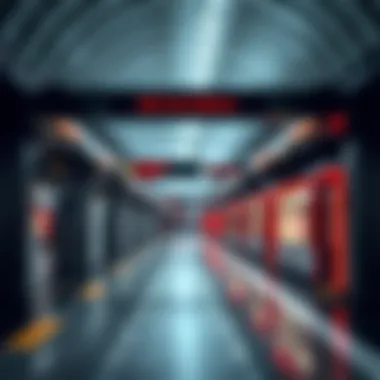
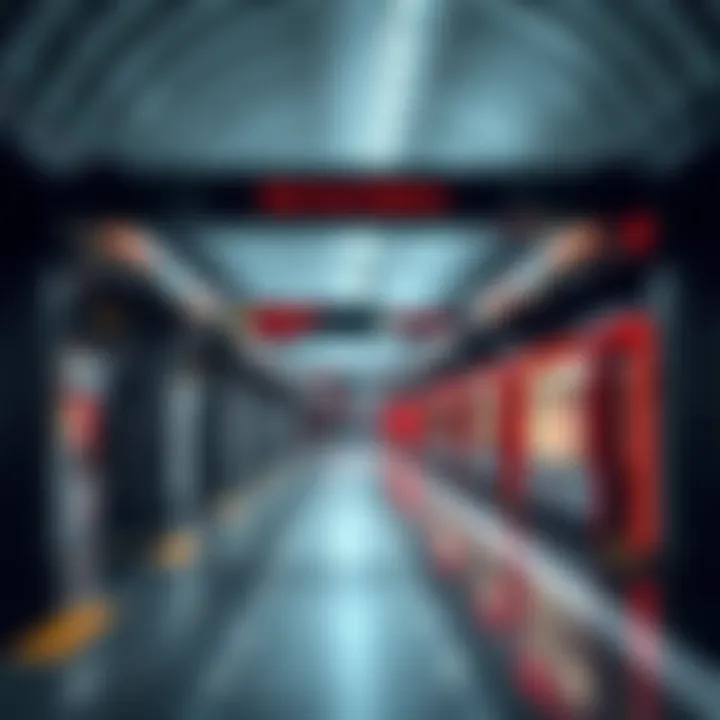
- Demographic Shifts: New developments attract a younger, more affluent crowd, pushing out long-time residents.
- Cultural Changes: As markets change, so does the character of neighborhoods. New businesses forego traditional shops, altering community dynamics.
- Investment Opportunities: Investors aim to capitalize on the rising property values, often leading to new developments that cater to higher-income residents.
However, it’s crucial to approach this trend with caution. While some see only the bright side of investment gains, others face the darker realities of displacement. Ensuring a balance between growth and community preservation is imperative for the long-term sustainability of neighborhoods impacted by the Red Line.
"The true challenge lies in fostering development that respects the existing community, rather than simply displacing it for profit."
Future Developments in the Red Line Network
The journey of the Red Line Metro in Dubai is far from reaching its final destination. As the city's skyline transforms and expands, the metro network must evolve to meet the growing demands of residents and visitors. Future developments in the Red Line Network stand as an important focal point, showcasing Dubai’s vision for sustainable urban growth. This section discusses proposed station additions and the broader expansion plans that will shape the metro’s trajectory in the coming years.
Proposed Station Additions
A number of proposed station additions to the Red Line Metro could significantly enhance accessibility and convenience for commuters. These new stations aim to address congestion hot spots and link areas currently lacking efficient transit options. Some proposed locations include:
- Dubai South: This new station would cater to the burgeoning developments in Dubai South's residential and commercial sectors. Given the area's plans for a new airport and other infrastructure, the inclusion here is vital.
- Mohammed Bin Rashid City: Adding a station near this massive planned development would facilitate smoother flow to residential areas and attractions.
- Expo 2020 Site: Even post-Expo, the site is destined for continued growth. A dedicated station could keep it alive as a point of connectivity.
Each proposed station is not just a matter of adding stopovers. They are critical to fostering economic opportunities and enhancing community engagement in regions that might otherwise be fragmented.
Expansion Plans
The expansion plans for the Red Line do not just involve adding new stations; they include extending current lines and introducing upgrades to existing infrastructure. Here are some key aspects:
- Line Extensions: Proposals to extend the Red Line into new neighborhoods could link underserved regions with the heart of Dubai. For instance, a southern extension could connect to suburban areas, making it more feasible for locals to reside further from the city center.
- Increased Training Capacity: Insights from current ridership statistics indicate that during peak hours, the system faces significant strain. Future plans involve increasing train frequency and possibly introducing longer trains. This would accommodate the swelling numbers of daily commuters effectively.
- Sustainable Technologies: Innovating with LED technology and energy-efficient trains will diminish the environmental footprint of the network. As Dubai strives for a greener future, integrating smart technologies into the metro system is a move in the right direction.
"The expansion of the Red Line is not merely about transport; it interlinks communities and fosters a sustainable urban environment."
Using the Red Line Metro System
Using the Red Line Metro in Dubai offers a window into how the city’s infrastructure supports its rapid growth and urbanization. This section highlights its importance for daily commuters and tourists, revealing its advantages and factors to consider while navigating the system.
Ticketing and Pricing
When it comes to getting around the city, understanding the ticketing and pricing structure of the Red Line Metro is essential. The Dubai Metro operates on a smart fare system that promotes smooth travel and affordability. Here’s a breakdown:
- Nol Card System: The Nol card is the backbone of the ticketing system. Users can choose between standard, silver, gold, and blue cards based on their needs. It’s simple to reload and can be used for multiple journeys.
- Pricing Structure: Fares range from AED 3 to AED 8.5 based on the distance traveled. The longer your journey, the higher the fare. This tiered pricing encourages local travel while being accessible for tourists.
- Costs against Convenience: While the fares are reasonable, the metro system also offers savings when compared to other transport options, such as taxis which can be quite pricey.
For tourists looking to explore the city, day passes are available, allowing unlimited travel for 24 hours. This makes it easy to hop on and off, enjoying attractions without worrying about accumulating costs.
Travel Tips for Newcomers
Navigating the Red Line Metro for the first time can be daunting, but with the right approach, newcomers can find it quite manageable. Here are some travel tips to maximize their experience:
- Plan Ahead: Before embarking on a journey, familiarize yourself with the route maps and station lists. Apps like RTA’s Dubai Metro app provide live updates and detailed maps.
- Peak Hours Considerations: Metro usage peaks during rush hour, typically between 7:00 AM to 9:00 AM and 5:00 PM to 7:00 PM on weekdays. Travelling outside of these times can save you from crowded trains.
- Know Your Stops: Each station is connected to significant landmarks. For instance, the Burj Khalifa/Dubai Mall Station brings you extremely close to one of the world's tallest buildings. Knowing what’s nearby can enhance the travel experience immensely.
- Stay Mindful of Etiquette: Keep to the right on escalators to allow faster passengers to pass, and reserve special seating for those who need it. Keeping a low volume when discussing with others helps maintain a pleasant atmosphere in the metro.
As you navigate the vibrant landscape of Dubai, the Red Line Metro not only provides efficient transport but also enriches your understanding of the city's culture and dynamics.
Embracing the Red Line Metro system opens up a multitude of opportunities for discovery and connectivity. Grasping the ticketing nuances and planning your commute effectively paves the way for a fulfilling journey.
End
The exploration of the Red Line Metro System in Dubai reveals much more than just its practicality for transportation. It serves as a crucial component of the city’s ever-growing infrastructure and dynamic urban landscape.
Recap of Key Insights
Throughout this article, we've delved into various facets of the Red Line Metro. Key highlights include:
- Historical Context: Understanding how the Red Line emerged from Dubai's vision to modernize urban transit.
- Station Features: An in-depth look at each station, including Burj Khalifa/Dubai Mall and Dubai Marina, shedding light on their unique attributes.
- Impact on Neighborhoods: Analysis of the way metro stations enhance connectivity and spur development in surrounding areas, influencing real estate values.
- Future Plans: Discussion about proposed expansion and additions that hint at Dubai’s ambition to continue evolving its transit framework.
It’s evident that the Red Line plays a pivotal role in promoting seamless movement across key city zones, facilitating both commuting for residents and accessibility for tourists. Investors and homeowners alike should consider these insights as they gauge the implications of the metro system on property value and neighborhood desirability.
Final Remarks on the Red Line's Role
As more stations and expansion plans come to fruition, the long-term effects of the Red Line's existence promise to be far-reaching. This comprehensive overview stands as a vital reference for investors, homeowners, realtors, developers, and analysts keen on understanding the underlying drivers of Dubai's real estate market.
In a city marked by ambition, innovation, and rapid change, the Red Line continues to demonstrate that effective public transportation serves as both a facilitator of progress and a reflection of urban quality of life. For anyone engaged in the pulse of Dubai's market, noticing the metro's development and its implications becomes imperative.







